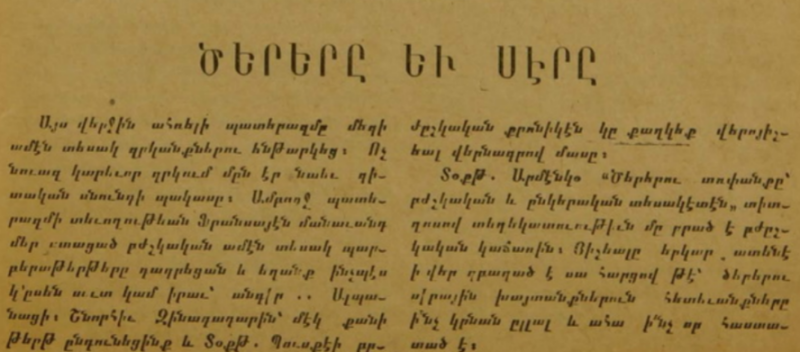Abortion, domestic violence, increase in mortality rate, decrease in birth rate, rise of sexually transmitted infections (STIs), older people’s sex lives… These present-day topics were likewise current in the Armenian press of the 19th century.
The first Armenian publication, Azdarar, was published in 1794, in Madras, India. Alongside periodicals with a focus on social and political issues, published were also thematic newspapers — on health, education, culture, youth, satire, religion, children, and so on.
In this article we’ll address press that focused on health.

The first health-focused newspaper was called Healthcare Newspaper (1881–1884, Constantinople). The newspaper’s epigraph reads: “Medicine is applied also among savage nations, but only enlightened nations live healthily.”
Incidentally, at the end of the 19th century, five publications dedicated to healthcare issues were published in Constantinople alone: Matenadaran (monthly periodical, 1882–1885), Gandz (weekly, 1885), Tangaran (monthly, 1884–1886), Punj (1891), and Arajnord Aroghjabnutyan (monthly, 1896).
The number of periodicals with a healthcare focus published since 1881 is 117.
After wars and the Armenian Genocide, there was a serious demographic problem. The lack of literacy was the cause of deaths. Aroghj Kyanq newspaper’s epigraph reads:
“The editorial office has decided to send all issues of Aroghj Kyanq for free to rural and urban schools, libraries and reading rooms, and Armenian companies. Only a nation that is healthy, powerful in number, and fit in quality can have healthy social and political ideals and implement those ideals.”

The paper published in Baku declared that it will “study the physical condition of the Armenian people and fight against all that contributes to the depletion and consumption of our national body.”
It wrote also in its first issue, which was published in January 1917, that “it will fight against all family and social obstacles that act as a barrier to the progress of our healthy and stately, balanced and powerful generation.”
The 20th century health press also featured disease and mortality statistics, according to years.
Published in Yerevan, the newspaper Aroghjapahik in 1920 presented data from 1906, 1907, 1908, 1909, and 1910, gathered from the former state health department and comprised of the annual reports received from the provinces.
“Recently, in both the city of Yerevan and its state, severely widespread are spotted fever (typhus), relapsing fever, and other illnesses that often happen during war… These illnesses have claimed many victims both in the city and especially in the villages, due to the inadequate organization of medical practice. Here is the real picture.”
It becomes clear that infectious diseases have led to death: in 1906, 644 became ill with and 232 died from scarlet fever; 506 became ill with and 158 died from diphtheria.
“In 1907, scarlet fever was abundant in the province: that year, 5,337 people became ill with scarlet fever, of which 1,164 died,” reports the March 1920 issue of Aroghjapahik.
Domestic violence, illiteracy of parents, and cruel treatment of children were widespread in Armenian families.

The article remarks that many boys, unable to withstand the physical and moral violence in families, either die or commit suicide.
The sex lives of the elderly also caught the attention of the health press.
The article “The Elderly and Love,” on the “effects of the love afflictions of the elderly,” debates whether the elderly can have a sex life and how such relations effect their health.
Incidentally, according to the article, “elderly” refers to those aged 60 and up. Is it dangerous to have a sex life at that age? “The conclusion is that a person close to 60 should refrain from familiar relations; otherwise, his last hour will come to an end” (Darman, 1920).

It turns out that STIs and premarital sexual relations were a serious problem in Armenian families at the start of the 20th century.
It had reached the point that, by the local government’s decision, the to-be-married couple had to undergo a mandatory medical examination.
Here is the “Exam for the To-Be-Marrieds” article: young people before getting married are obliged to be examined for the purpose of detecting venereal diseases, and only upon [receipt of] the appropriate medial document would a priest have the right to conduct the wedding ceremony in the church.
The author of the article is a doctor who highlighted the professional and psychological difficulties those in his profession faced in providing such a document.
During WWI, there were special articles on how soldiers could protect themselves from infections on the battlefield.
For example, to be protected from worms. On how worms, falling in the soldier’s food, can even cause paralysis, thus also changing the course of battle — in the enemy’s favor.
“In 1828, in the Russo-Turkish War, when the Russian army’s 100,000 soldiers crossed the border into the camp, the first shot of the war not yet fired, the brave 80,000 troops became infected with diseases, and that which killed the most was dysentery” (Buzhak, monthly periodical, April 1917).
The stories in these health-focused newspapers are extremely interesting from the perspective of the 21st century. Simple, applicable tips on how to be healthy and how to treat some illness or another. And not a word about treating cancer with baking soda and lemon…
Lilit Avagyan







